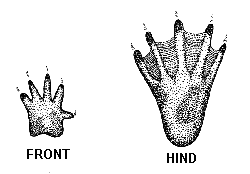 Beaver
Beaver
Castor canadensis
Description
- This very large, dark brown rodent has a black,
scaly tail which is horizontally flattened and paddle
shaped and used as a rudder while swimming , as a sturdy
support on land and for balance when the beaver carries
heavy tree branches or building materials in its front
paws. The back feet are large, webbed and black; the eyes
and ears small; incisors are very large and chestnut coloured.
Average weight is 45-60 pounds but they have been recorded
at up to 110 pounds.
Distribution
- The beaver occurs throughout most of Canada and all
of British Columbia in rivers, streams, marshes, lakes
and ponds.
Biology
- The beaver builds its lodge out of intertangled twigs and sticks; as
freezing weather nears they plaster the lodge with mud making a concrete
layer that no predator can break through. Predators include coyotes, wolves,
bears, lynx, and wolverines; mink, hawks and owls will also take some
kits.In late April to early July 3-4 kits are born. The beaver is highly
adapted to its aquatic life with webbed hindfeet, the rudder-like tail,
valves that close off the ears and nostrils, skin flaps that seal off
the mouth but leave the incisors free for underwater gnawing and carrying
and clear membranes that slide over the eyes protecting them from floating
debris. During the early nineteenth century the beaver pelt was the single
most valuable commodity; the pelt being used for robes, coats, clothing
trims, and top hats. Nowadays the pelt is still highly valued, the flesh,
and sometimes the tail, are considered tasty.

Tracks
- A perfect beaver track is rare as the tail drags and
will often cover the print. The hind foot is large, triangular-shaped,
webbed and has five toes. The forefoot is much smaller
with five toes although all are seldom evident. During
the winter the beaver's trail is often mistaken for that
of a porcupine or otter because of the trough created
by the beaver's trail. A closer examination of the track
will generally show a portion of a print.
Straddle: 15 - 20 cm (6 - 8 in)
Stride: 10 - 15 cm (4 - 6 in)
Track: Front - 8 cm (3.2 in) long / 7 cm (2.8 in) wide
Track: Rear - 15 cm (5 in) long / 12 cm (4.8 in) wide
|


